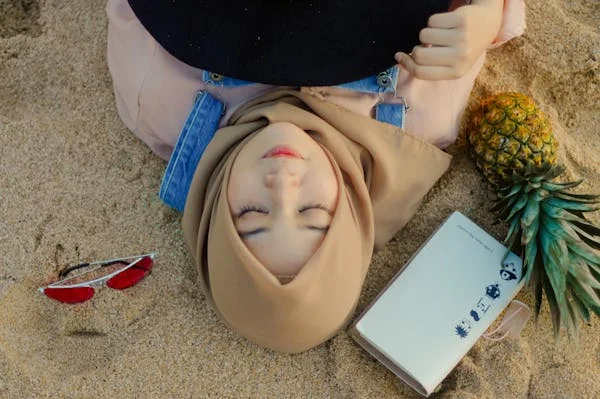Introduction
The world of fashion has always been a space for expression, creativity, and breaking boundaries. Over time, fashion has adapted to cultural and religious norms, creating new styles that blend the old with the new. One of the latest trends to emerge in the fashion world is Hijabhoojup. This style is an innovative combination of modest Islamic dressing, epitomized by the hijab, and the free-spirited, bohemian (boho) aesthetic. It allows women to blend modesty with the freedom of expression through fashion, offering a unique fusion that is both stylish and culturally rich.
Hijabhoojup is not just about the clothes it is a representation of a new way of thinking, where personal identity, faith, and modern fashion come together seamlessly. This style transcends the typical understanding of modest fashion, making it not only a spiritual choice but a fashion statement in its own right.
The Origins and Meaning of Hijabhoojup
What Is Hijabhoojup?
At its core, Hijabhoojup is a combination of two significant cultural and fashion elements: the Hijab and Bohemian Chic.
- Hijab: The hijab is a traditional garment worn by Muslim women to cover their hair and neck, symbolizing modesty, privacy, and morality. The hijab has been worn for centuries and is an important part of Islamic culture and identity. It is a physical representation of a woman’s faith and commitment to modesty.
- Bohemian Chic (Boho): Bohemian fashion, often referred to as “boho,” is a style inspired by the counterculture movements of the 1960s and 1970s, with its roots in the bohemian lifestyle. It embraces freedom, individuality, and nonconformity. The boho style is known for loose, flowing garments, ethnic prints, earthy tones, and an eclectic mix of textures and accessories.
Hijabhoojup merges these two seemingly opposite styles to create something fresh, unique, and empowering. It allows Muslim women to incorporate their cultural values into modern fashion without sacrificing their beliefs or identity.
The Emergence of Hijabhoojup
The modern world is rapidly evolving, and with it, traditional clothing and fashion are also undergoing significant changes. In recent years, there has been a growing demand for modest fashion that combines contemporary trends with cultural and religious values. Hijabhoojup emerged as part of this global shift, where Muslim women are finding innovative ways to express their identities while adhering to their faith.
What makes hijabhoojup special is its versatility and inclusivity. It allows women to dress modestly while staying on-trend and confident in their appearance. It empowers women to feel both fashionable and spiritually aligned, thus redefining the way we look at modest fashion.
Key Components of Hijabhoojup
Hijabhoojup isn’t just a trend it’s a style philosophy that blends modesty with creativity, featuring key elements that define it.
1. Loose, Flowy Garments
Modesty is the cornerstone of the hijabhoojup look. Loose, flowy garments that provide coverage while maintaining comfort are the foundation of the style. These garments often include oversized dresses, maxi skirts, tunics, and long coats. The key is that the clothing does not cling to the body but instead flows gently, allowing for movement while maintaining a sense of privacy and modesty.
Loose clothing also embraces the freedom and relaxed vibe that bohemian fashion represents. Whether it’s a casual dress, a long tunic, or a flowing maxi skirt, the aim is to keep the silhouette simple, unrestrictive, and graceful.
2. Layering for Depth
One of the defining features of boho-chic fashion is layering. Hijabhoojup embraces this concept by using layers to create depth and texture in the outfit. This can involve layering cardigans over tunics, wearing scarves over long-sleeved tops, or pairing skirts with long jackets. The goal is to add dimension and visual interest without compromising on modesty.
Layering also offers the added benefit of extra coverage. The idea is to make the outfit look more dynamic and stylish, while still staying true to the principles of modesty.
3. Earthy Tones and Natural Fabrics
Boho style is known for its use of earthy colors, and hijabhoojup incorporates this aspect as well. Shades like beige, brown, olive green, mustard, and burgundy dominate the palette. These colors not only evoke a sense of nature but also reflect simplicity and comfort two important elements of the bohemian aesthetic.
When it comes to fabric, natural, breathable materials such as cotton, linen, chiffon, and wool are preferred. These fabrics are perfect for creating the fluid, airy, and comfortable feel that hijabhoojup aims for. Natural fabrics are also easy to wear in different climates, offering both practicality and style.
4. Accessories for a Personal Touch
Accessories are a hallmark of the boho style, and hijabhoojup is no exception. From chunky jewelry to statement scarves, accessories play a significant role in completing the hijabhoojup look. Popular accessories include:
- Layered necklaces or statement earrings.
- Wide-brimmed hats that add a relaxed touch to the outfit.
- Colorful scarves or headbands that complement the hijab.
- Leather handbags with ethnic patterns.
- Ethnic or crochet shawls for additional warmth or flair.
The beauty of hijabhoojup is that it allows for individual expression through accessories. Women can add their personal touch by choosing items that resonate with their personalities and preferences.
5. Artistic Patterns and Textures
Bohemian fashion embraces a variety of prints and textures, from floral patterns to geometric shapes and ethnic-inspired prints. Hijabhoojup allows for a mix of these patterns, bringing an artistic touch to the outfits. The hijab itself may feature embroidered designs or be paired with patterned shawls and scarves. Similarly, the clothing may feature intricate embroidery or textured fabrics, adding depth and interest to the overall look.
6. Footwear and Outerwear
Boho chic fashion incorporates comfortable yet stylish footwear, such as sandals, ankle boots, and flats. Hijabhoojup outfits are often completed with minimalistic but fashionable shoes that complement the earthy and natural elements of the look. Outerwear such as long cardigans, trench coats, or oversized jackets also play a vital role, offering additional layers of warmth and coverage while enhancing the overall aesthetic.
The Popularity of Hijabhoojup in Modern Fashion
Hijabhoojup is a modern interpretation of modest dressing that offers a fresh take on how women can express themselves through fashion. The rise in popularity of this style can be attributed to several factors:
1. Modesty Meets Modern Trends
As the world becomes more connected, many Muslim women are looking for ways to express their individuality while staying true to their values. Hijabhoojup allows for this balance by blending traditional modesty with modern trends. Women can now wear modest clothing that reflects current fashion movements without compromising on their faith.
This fusion of modesty and contemporary fashion is especially appealing to young Muslim women, who want to dress stylishly without feeling like they are giving up their cultural or religious values.
2. Empowerment through Fashion
Hijabhoojup is empowering because it provides a platform for Muslim women to embrace their culture and religion proudly while also looking fashionable. The freedom to express one’s identity through clothing is a powerful statement in a world where women often feel pressured to conform to societal standards of beauty and fashion.
Hijabhoojup offers women the opportunity to create their own style, which is both personal and culturally significant. It shows that fashion can be a tool for empowerment, allowing women to feel confident, fashionable, and faithful all at the same time.
3. The Role of Social Media and Influencers
Social media has played a crucial role in the rise of hijabhoojup. Platforms like Instagram, Pinterest, and TikTok have become spaces where influencers and fashion bloggers showcase their interpretations of hijabhoojup. Influencers such as Dina Tokio, Nabila M. Arif, and Mariam Mohammed have helped popularize modest fashion trends and have made hijabhoojup a global phenomenon.
Through their social media platforms, these influencers are demonstrating that modest fashion doesn’t have to be dull or restrictive it can be fun, creative, and empowering.
4. Global Fashion Weeks and Modest Fashion Events
The increasing representation of modest fashion on global runways and fashion weeks has also contributed to the rise of hijabhoojup. Designers like Hana Tajima and brands like Haute Hijab are making waves by offering stylish, high-quality clothing for Muslim women that merge modesty with the latest fashion trends.
Events like the Modest Fashion Week in Dubai and London also help showcase the growing influence of modest fashion in mainstream culture. These events provide a platform for designers, influencers, and women from around the world to come together and celebrate the diversity and creativity of modest fashion.
How to Style Hijabhoojup: Tips for Women
1. Layering with Purpose
Layering is key to the hijabhoojup look. It’s important to choose garments that flow well together while maintaining the right balance. Start with a basic tunic or long dress, then layer it with a scarf, jacket, or cardigan. This allows you to add more depth and dimension to your outfit without compromising on modesty.
2. Embrace Color and Texture
Don’t be afraid to mix and match earthy tones and vibrant colors. The boho style allows for an eclectic mix of prints and textures, so feel free to experiment. Whether it’s floral patterns, stripes, or tribal prints, combining various textures and prints will give your outfit a unique and personalized look.
3. Accessorize Wisely
Accessories are where you can really let your personal style shine. Choose statement jewelry, hats, and scarves that align with your overall aesthetic. Don’t overdo it boho style is about subtlety and balance. Let one or two key accessories stand out, while the rest complement the outfit.
4. Opt for Comfortable Footwear
Since hijabhoojup is all about comfort and freedom of movement, make sure to choose shoes that are both stylish and practical. Flats, sandals, and ankle boots are excellent choices, depending on the weather and occasion.
5. Mix Modesty with Confidence
Above all, the most important aspect of hijabhoojup is confidence. Wearing clothes that reflect your personality and faith will naturally boost your self-esteem and help you feel comfortable and at ease in your own skin.
Conclusion
Hijabhoojup is more than just a fashion trend it’s a cultural movement that empowers Muslim women to embrace their faith while looking stylish and modern. This fusion of modest Islamic dressing and bohemian style represents a harmonious blend of tradition and innovation. Hijabhoojup offers an opportunity for self-expression, allowing women to wear what they feel comfortable in while staying true to their values.
As the world continues to evolve, so does fashion. Hijabhoojup is a perfect example of how cultural and religious norms can adapt to the fast-paced, ever-changing world of fashion, creating a space for Muslim women to express themselves creatively, confidently, and modestly.



